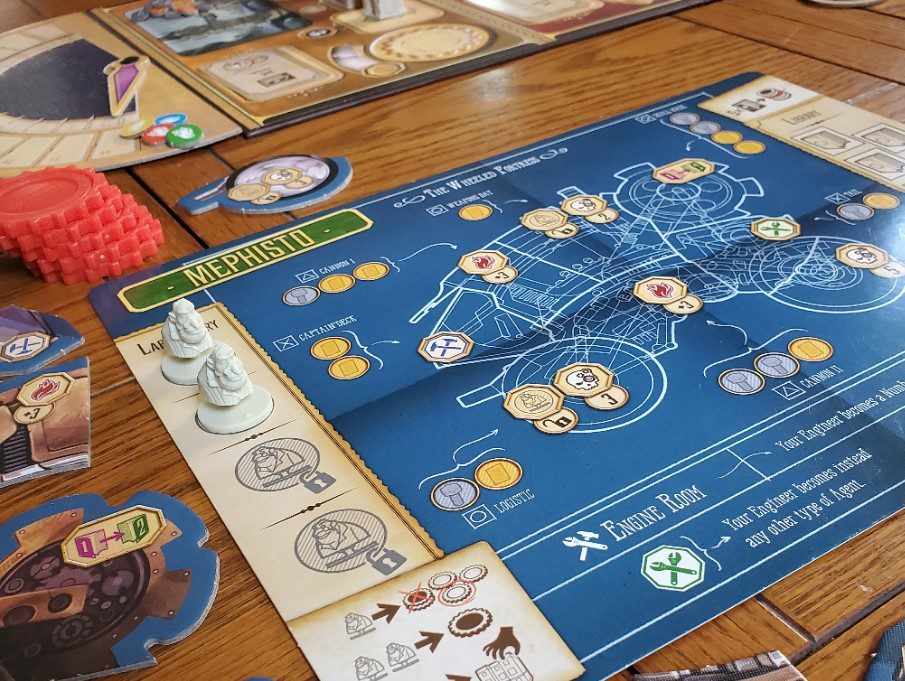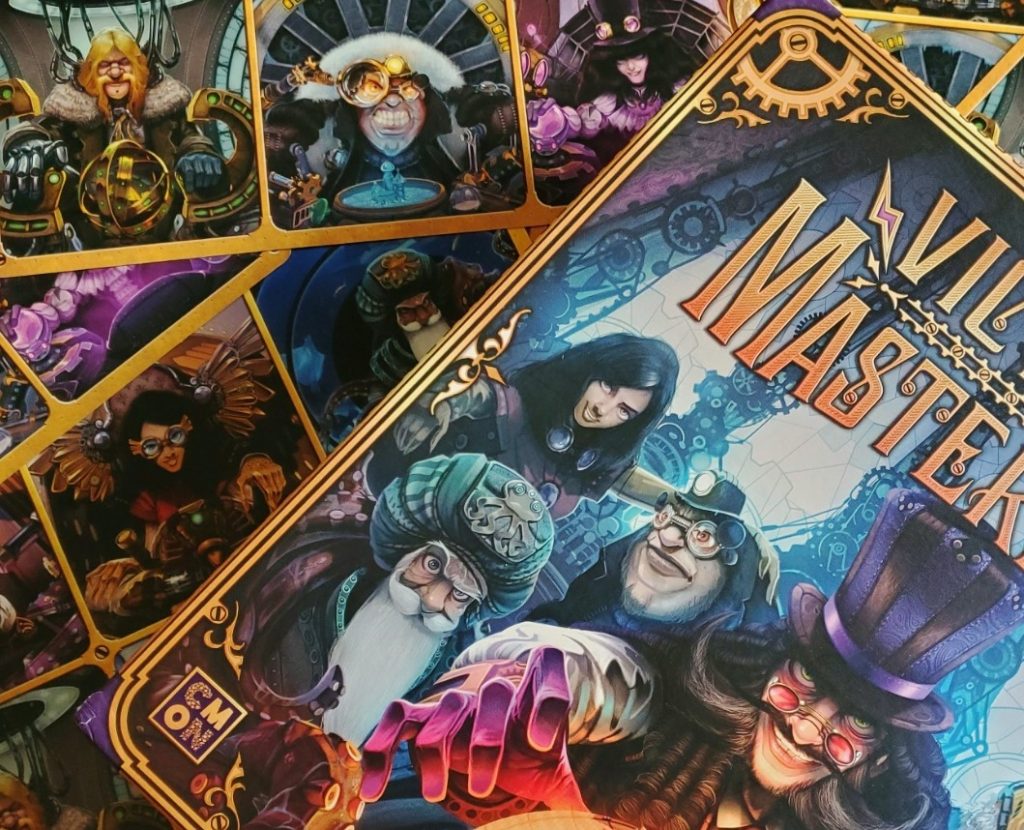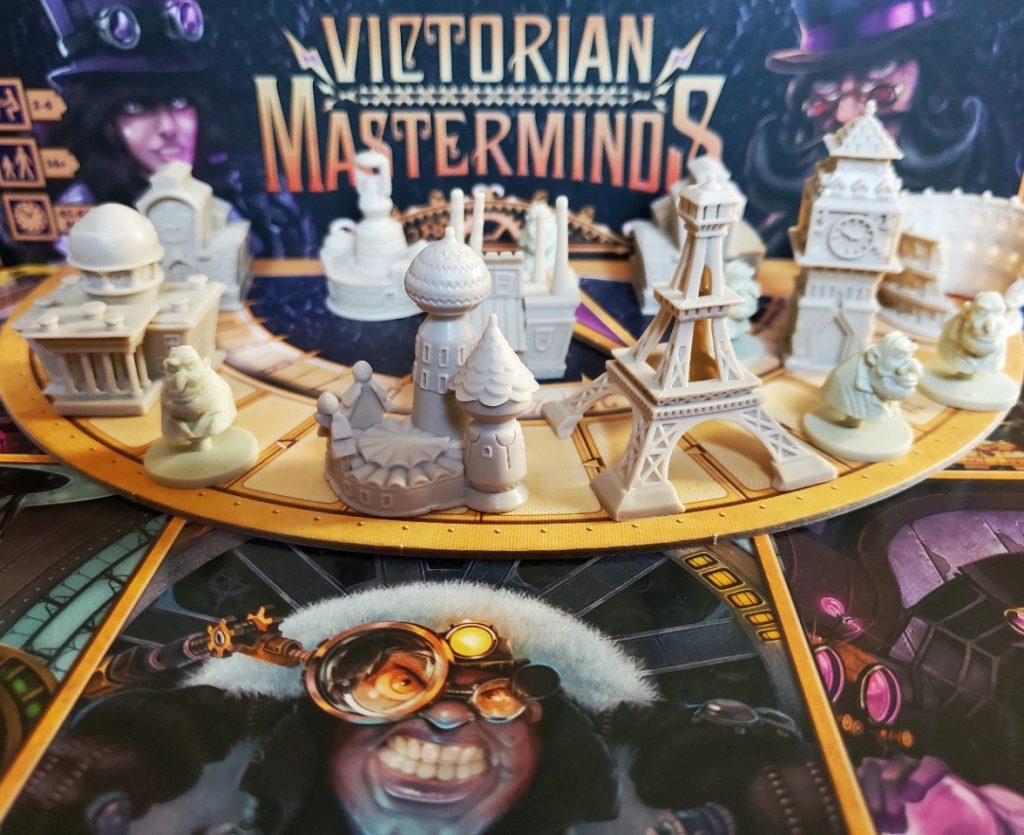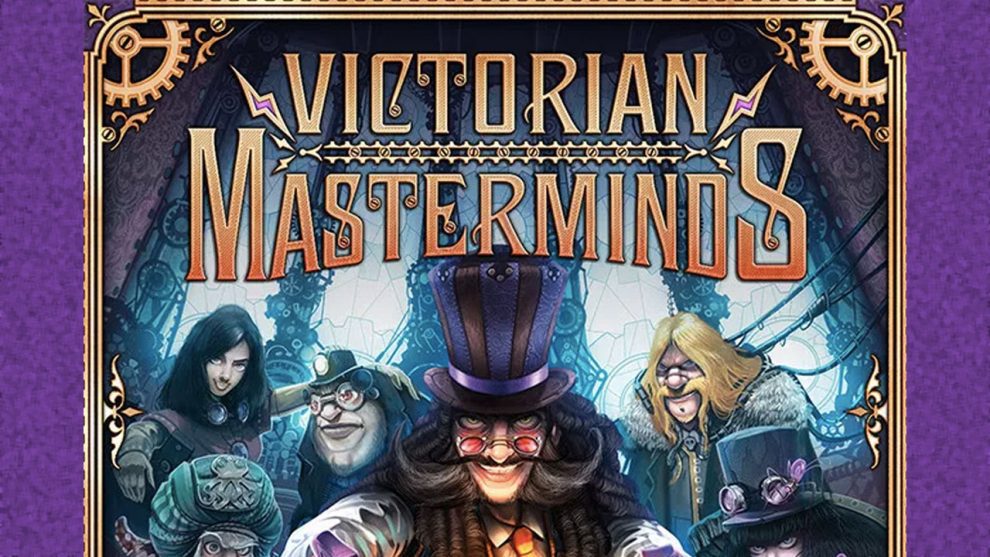Global villainy is on the rise in the Victorian era, but rather than help to restore order, you want a piece of the chaotic action! Sherlock Holmes is nowhere to be found, and the world’s treasures are at risk.
Victorian Masterminds, designed by Antoine Bauza (7 Wonders, Tokaido) and Eric M. Lang (Bloodborne, Rising Sun) and published by CMON, is an open call for two to four would-be criminals who have ever watched a classic cinema super-villain and said, “I could’ve pulled it off, and with more style.”
Villains race to build their comically capable machines of mayhem, kidnapping scientists, stealing valuable codices, and capturing whole buildings and precious landmarks. They do so by deploying specialized agents and out-maneuvering the vague and hardly menacing Secret Service. In the end, only one villain can stand tall to claim the distinction of Victorian Mastermind.

The Plates and Bolts of Villainy
This game has pieces! Cards and more sheet-size cards. Cardboard tokens galore. Fantastic plastic gears. Whimsical architectural minis. Countless replicas of the bust of a single scientist. Over 300 pieces of varying material, size, and importance. Thankfully, they all have a home in the box and on the game board (though neither would necessarily withstand being turned upside-down!).
Players receive a unique machine sheet at the beginning of the game. Each sheet has a corresponding puzzle of eight cardboard pieces that will be used to build the mischievous device. Players also confine a number of scientists to cells in the machine at the outset. Finally, each villain receives a set of agents who will do their dirty bidding.

The game board is divided into five cities – London, Moscow, Paris, Rome, and Washington. Each city boasts a particular spoil (and copious corresponding pieces) that will benefit the villains along the way:
- Copper Plates and – maybe galvanized? – Bolts are used to build the machine.
- Captive Scientists assist the villainy by enabling additional agents and capturing buildings through unspecified science-ing.
- Da Vinci Codices provide Mayhem (Victory) Points, because reading is winning, and eventually grant the ability to better coordinate agents later in the game.
- Brute Firepower is accumulated in order to capture buildings (which the classic Carmen Sandiego fan in me assumes to mean actually stealing whole buildings from their foundations).
Finally, each city holds an objective card and several key buildings all ripe for the taking when the circumstances are right. The Secret Service gauge rests atop the board as a measure of every player’s current firepower compared to the awareness of the seemingly impotent law enforcement agency.

Criminal Gameplay
On each turn, villains will put one agent up to no good by placing them face-down in a given city. At the outset of the game, players have no choice but to employ the top agent on the stack, but hitting the right codex count opens up the ability to choose freely from the bunch.
When a third agent is placed in any one city, the agent stack is then flipped and resolved, with each player carrying out the appropriate actions in the order of their choosing. First, they may collect the spoils of the city and put them into use. Also, if possible, they may utilize their special ability:
- Number 2 collects the city’s spoils a second time.
- The Henchman attempts to complete the city’s mission card.
- The Gunner attempts to utilize firepower to capture a building in that city and the accompanying bonus spoils.
- The Saboteur halts the special ability of the next agent in the stack (Sneaky!).
- The Engineer executes the machine’s special abilities.

Resolved agents move to a discard pile until the entire group has been employed, after which they are shuffled and stacked to await their next assignment. Machines develop, buildings disappear, missions are accomplished, codices are read.
The game continues in this fashion until one player completes their machine OR the Secret Service alert level rises to 12, which happens as a result of stealing so many buildings. Players take their last turns and the Mayhem points are counted to determine a winner.
Diabolical Scoring
There is more than one path to victory in Victorian Masterminds, but every strategy will dabble in each field of scoring:
- Machine points achieved through upgrades
- Building points from each captured construction
- Mission points from the cards acquired by the Henchman
- Codex points from… reading, of course!
- Mayhem point tokens acquired throughout the game
Fiendish Highlights
Of all the agents, the Engineer is the most engaging and, occasionally, the most confusing (I’m looking at you, C.L.A.W.S.). Each machine has a unique standard ability that the Engineer will resolve, giving the game a nice asymmetrical touch. As the machine acquires certain pieces, even more abilities are unlocked, unleashing opportunities for combos and straight-up point scoring. The proper use of the Engineer is critical to strategic success.
And speaking of those malevolent machines, each consists of eight pieces that unlock various advantages in the game in the form of Firepower, Mayhem (victory) points, additional cells for Scientists, and increased Codex value. The order in which the machine is built affects multiple agents and figures prominently in the overall strategy. Understanding the machine is another key to Victorian victory.

A Brilliant, but Unfinished Theme
The theme of Victorian Masterminds is mostly well-executed. The many pieces are high in quality and wonderfully quirky. The artwork is spectacular – Davide Tosello (Sheriff of Nottingham 2nd Ed., Orbis) is to be applauded for creating a beautiful bevy of characters and equipment… that deserves a more complete integration.
There are six sinister villains on the cover of the box, and not one of them has a name. Not one of them appears anywhere in the gameplay, even though they are on nearly every page of the rulebook. It is as if the design team ran out of time and forgot to give their game its critical human element!

The machines have names. The agents have weight. But my goodness I want to know about the Captain-Nemo-looking fellow! I want to hear the backstory and diabolical schemes of the lady-Hyde with goggles on her tophat! How did the viking-ish dude come to need that band-aid on his nose? And what about that fishy looking guy/thing?
Call me demanding, but I believe I shouldn’t have to ask these questions! Help me out Antoine! Help me Eric! The kettle of the Victorian era is steaming and screaming on the cover, but the theme isn’t fully steeped. If I have a complaint, it is the dissonance between the theme and, well, the theme. Even if I am simply aiming to join the ranks of these villains and it’s actually all about me, I want to know more about the gang!
Even better yet, I might have enjoyed meeting them somewhere along the way as either a help or a hindrance in my pursuit of underhanded supremacy. Consider this my official request for an expansion.
A Quirky Keeper
Nitpicky gripes aside, I absolutely adore this game. (Which is why I want so badly to see the theme fully utilized!) My whole family loves this game. I would compare it to a solid adventure movie, one that would never merit Oscar consideration or a score above 7.0 on IMDb, but one that has the sort of pacing and soundtrack you can never walk away from once it’s on the screen. (National Treasure, anyone?) Bauza and Lang delivered a light, fun adventure that holds your attention while it’s on the table, and a solid period-specific Spotify playlist would be a welcome consideration if anyone is into creating that sort of thing.
The components are sturdy and fun to handle. The plastic gears are guaranteed to be among your favorite worker-placement tokens by the end of the game. They are fun to fidget, fun to shuffle, and satisfying to use. Likewise for the minis. There is something captivating in collecting heisted buildings and unsuspecting scientists for 45 minutes. If you’re into painting miniatures, this game has the potential to be quite stunning.

In terms of gameplay, the decisions are engaging. Waiting for a third agent to show up in any one location can, at times, force a less-than-ideal move in the name of greed, speed, or retrieving a useful agent. Setting up a string of resolved agents to carry out a particular task can be exceptionally gratifying. Choosing which machine pieces to develop, and in what order, creates just the right amount of tactical consideration to keep everyone attentive.
Some of the tension involves the game’s pace. Will you aim to drive the tempo by stealing buildings, or slow it down by pursuing scientists and mission cards? Players sometimes attempt to sprint to within one piece of finishing their machine, only to then drag out the game in the hope of scoring points while continuously threatening the end—but knowing when to pull that trigger can be tricky. And because someone else might walk a similar line, the whole mishmash of villains has to keep a sharp eye out.
Scoring is typically tight enough that folks rarely feel they’ve been left behind. But as the tally is counted, there is little doubt that the victorious villain was the one most capable of reacting to the situation on the board with the most foresight and efficiency. The winner often is the Mastermind.
Victorian Masterminds is a worthwhile caper. If the concept resonates with you at all, I say check it out! It may not be the Citizen Kane of gaming, but you just might find yourself playing back-to-back adventures while all those pieces are out.
One Year Later…
Victorian Masterminds was on the table just a week ago with all its quirky goodness. Though its tensions are somewhat repetitive, the strange thing about this game is that I’m always excited to enter the race. There are only so many machines, and each machine—primarily via the Engineer—is only a slight twist on every other, yet I come back time and again. I want to see if I can gather a full collection of upgraded Codices. I want to see if I can employ my scientists to their diabolical potential. I want to see if I can ignore Firepower altogether and still win. The subtle variety lingers and calls out from the shelf. And I smile as I grab the box, because I know I’ll be able to draw enough of the family in to make the hour worthwhile.












Add Comment